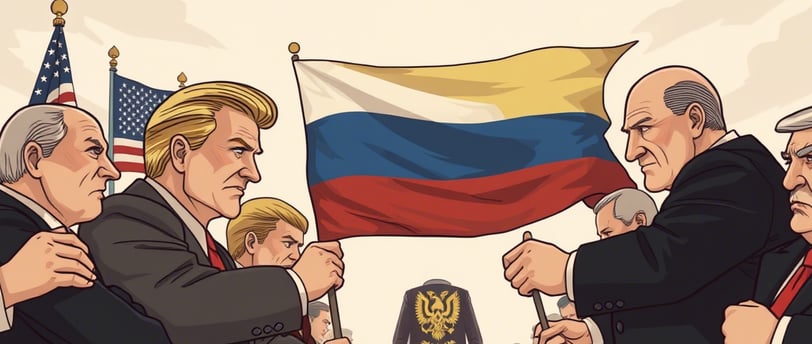The Labyrinth of Peace in Ukraine
In the complex geopolitical chessboard of today, the limitations of U.S. power are becoming evident. We analyze how economic and strategic equilibriums are redefining international relations under the Trump administration.
I. L. R.
3/19/20253 min read


The Reality of Power: Trump Faces Limits to His Global Influence
The Ukrainian conflict appeared to be nearing its final phase, given Trump’s firm stance against the continuation of hostilities.
However, after two months in the White House, Trump has come to realise firsthand that U.S. hegemonic power is no longer absolute.
Today, on Breaking Bucks , we analyse what lies behind the peace negotiations between Russia and the U.S. Follow us on Twitter to stay updated on new posts.
Tariffs and Retaliation: The Global Response to Trump’s Protectionism
His tariff policy, far from intimidating trading partners, has instead infused them with a combative spirit, prompting retaliatory measures.
Neither Europe, Mexico, nor Canada desires a trade war, but they know they hold cards to counter an increasingly cornered United States—stressed by multiple geopolitical fronts and a domestic economy strained by deficits, debt, and inflation.
On the other hand, China doesn’t even blink at Trump’s tariff threats.
Gaza in Flames
Israel has ended the fragile ceasefire in Gaza after negotiations for the release of hostages failed to progress.
Trump, who seeks stability in the Middle East, finds his ability to pressure Israel and Hamas into an agreement limited.
Ukraine on the Chessboard: Trump’s Dilemma Between Diplomacy and War
Ukraine is no different from other fronts. It’s clear that Trump lacks bargaining power. Two months have passed, and he has yet to bring both sides to the negotiating table.
On one side, he faces a morally emboldened Russia with time on its side; on the other, a Zelensky who seems to have nothing left to lose.
The situation on the battlefield demands an end to a war prolonged only by the ambitions of bureaucrats and private interests. Russia has already won, and with each passing day, the spoils grow larger.
Trump’s aggressive strategy has its advantages. But claiming he could end the Ukraine war within 24 hours gave him political capital that he now must repay. Time is also working against Trump.
Zelensky knows this—and wants his slice of the pie. He understands that peace benefits both Russia and the U.S.
By refusing to sign the Istanbul agreements, the Ukrainian president prioritised political interests over those of his citizens. Believing that could change now would be, at the very least, naive.
Playing for Time: A New Roadmap to Peace
In this context, Trump advocates for a more realistic strategy. He accepts the political cost of delaying peace while time strengthens his negotiating leverage against Ukraine. Meanwhile, his team works to lay the groundwork for what Trump envisions as a renewed “friendship” with Russia.
Talks are underway about dividing Ukraine’s rare earth spoils, energy cooperation treaties, and even reopening Nord Stream 2 under U.S. mediation.
This umbrella, under which both powers would profit, would act as an added guarantee for Russia. American economic interests would deter all parties from adopting a belligerent stance.
Ceasefire or Delaying Tactic: Who Benefits from the Pause?
Proposing a ceasefire may seem absurd or unrealistic. Russia would never agree to a timeout when it has its opponent on their knees, waiting for the final blow.
But floating the idea has succeeded in getting European bureaucrats and Zelensky onboard the truce train, while Putin, from the other side of the Dnieper, shows his most conciliatory side.
Putin has made it clear he would support a ceasefire—but past agreements like Minsk I and II, along with Western promises regarding NATO expansion, have proven to be worthless paper.
Putin wants lasting and definitive peace.
Whether this appearance is genuine or not is irrelevant. For Trump and Putin, what matters is keeping the ball in the court of the so-called “Coalition of the Willing” for as long as possible, ensuring they bear the weight and consequences of the war.
The End of the Conflict: Possible Scenarios
A new armistice akin to the one between North and South Korea is highly unlikely. Russia sets the conditions and will not allow Ukraine to remain armed.
The conflict will likely end either through a peace agreement or the collapse of Ukraine’s defences before year’s end. In any case, the outcome will be much the same—Russia’s objectives are already secured.
The concession of Russophone oblasts, Ukraine’s demilitarisation, and constitutional neutrality would place Russia—and particularly Putin—at the top of the podium.
The idea that Russia might want more than that is not a serious argument. It’s simply a slice of the pie Russia couldn’t possibly digest.
